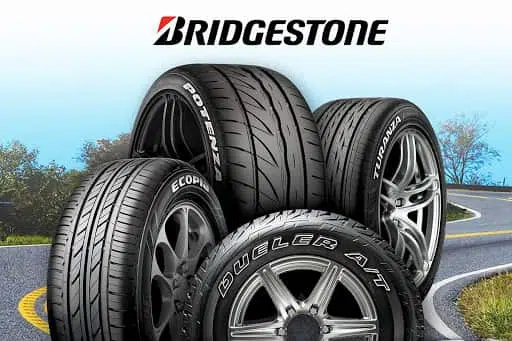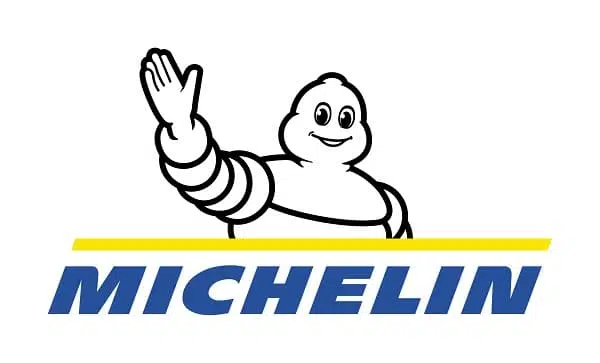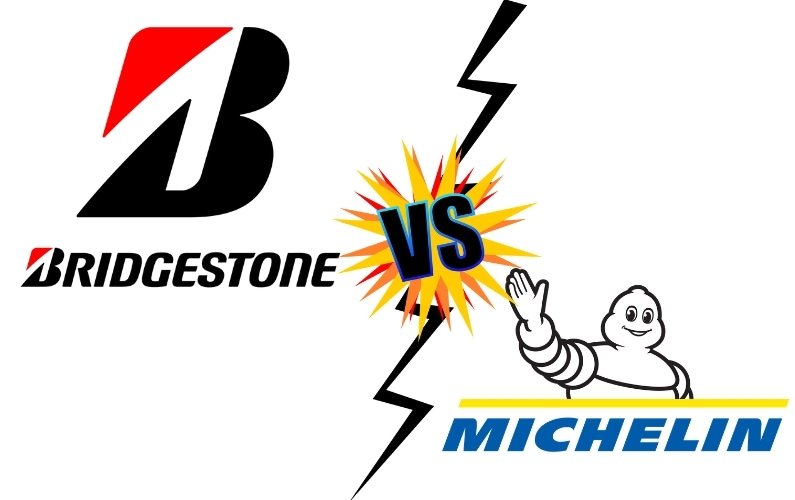“This post contains affiliate links, and I will be compensated if you make a purchase after clicking on my links.”
Many people asked me the age-old question – is Bridgestone or Michelin better? And, the answer is not as straightforward as you might think. Moreover, if you consider tires from these brands, you’re in a very good spot already. Both companies are at their peak right now, and they have been throughout history.
And, you surely won’t go wrong if you choose either brand. All tires from Michelin and Bridgestone are one of the safest around, especially in the conditions they are intended for. Besides, both companies produce some of the longest-lasting tires around, and most of their products are quiet and comfortable.
In addition, Bridgestone and Michelin are by far the largest producers of tires in the world. The Japanese brand had a more successful 2019 with $24.05 billion in sales, while Michelin finished with $22.13 billion. For reference, the third-largest tire manufacturer is the American Goodyear, which recorded $14.8 billion in sales. Meanwhile, the German Continental AG recorded $10.78 billion in sales.
Furthermore, both companies own other popular tire brands. Bridgestone is the owner of Firestone, which is the biggest acquisition of the company in its history. The Japanese company also owns Bandag and Daytona, and even CFNA and Tires Plus.
Meanwhile, Michelin owns multiple tire brands, including Kléber, a popular tire in Europe, and Uniroyal-Goodrich Tire Company, the producer of the well-known BF Goodrich Tires. Michelin also owns the European budget tire brand Riken.
So, Bridgestone and Michelin tires are excellent, which, of course, doesn’t stop us from diving deeper. There are some minor differences between the brands and how they develop and design their tires. To make things even clearer, I’ll cover each category of tires, including touring, performance, highway, and all-terrain tires.
Before we do that, though, why not learn something about the history of the brands before we jump to the comparison part.
New Year Sale @Priority Tire
Valid through January 13, 2023
Available at PriorityTire.com
Bridgestone Corporation History

Bridgestone is a Japanese multinational manufacturer of car parts, primarily tires for passenger cars and commercial trucks. The headquarters of the company is in the city of Kurume, Fukuoka, Japan. Curiously, the name of the brand comes from the surname of its founder, Shojiro Ishibashi, which translates to “bridge stone.” The company was founded in 1931.
When Ishibashi started the company, it worked mostly with footwear. However, the company later used the knowledge gathered in the production of rubber-soled tabi to expand the business into tires. At first, the business wasn’t booming, but the continuous growth led to the Bridgestone Corporation in 1984. Since then, the Japanese manufacturer is one of the biggest tire makers in the world.
One of the biggest moves of the tire maker was to acquire the American giant Firestone in 1988. Bridgestone bought the brand, but also the manufacturing plant in Nashville, Tennessee.
Michelin History

Michelin has a much richer history than Bridgestone. The company was founded in 1889 by Édouard Michelin and André Michelin. The company only produced rubber by then. However, Michelin quickly realized the need for bicycle tires.
Curiously, tires in the 19th century were glued directly to the wheel, which made it impossible to replace the tire. The brothers then created the world’s first removable pneumatic tire, similar to every tire you see on public roads today. Yes, Michelin literally created modern tires.
The French company is also behind other significant inventions. The Michelin brothers discovered the run-flat tire in 1934, a design that is widely used today. Moreover, they also discovered the radial tire, which significantly improved safety on public roads.
Today, every passenger-car tire has a radial design. The older bias-ply tires have significant disadvantages, including faster wear, worse high-speed stability, weight, performance penalty, and higher fuel consumption. You should definitely thank Michelin for all these advancements in the last century.
One of the biggest acquisitions of Michelin was the purchase of B.F. Goodrich Company and Uniroyal, Inc. in 1989.
The brand is also known for the Michelin Guide, which gives stars to high-end restaurants. A restaurant with one star is a very good one in its category. Two-star restaurant means “excellent cooking, worth a detour,” while a three-star restaurant means “exceptional cuisine, worth a special journey.”
The Michelin brothers created the guide to help motorists in the 1900 find restaurants when on the road. Remember, at that time, people had no GPS or navigation, so the Michelin Guide was the only book that could’ve helped when you travel in your car.
What are the Qualities that Both Companies Share?
Given the fact that Bridgestone and Michelin are the fiercest rivals in the tire industry, you might expect that they are similar in some aspects. And, indeed, they are.
Tires coming from these companies almost always cost more than the competition. Between the two, Michelin tires might be more expensive, but only slightly.
Moreover, both companies focus on producing safe tires. You will always get reliable traction in dry and wet conditions with Bridgestone and Michelin tires. Moreover, these models always finish among the best in their respective categories.
Michelin and Bridgestone put a lot of emphasis on durability as well. Tires from these manufacturers usually have very long treadlife, and also come with long treadwear warranties. Besides, companies employ high-end fuel-saving technologies. These not only save money for the owner but also contribute to less pollution.
The companies also concentrate on producing comfortable tires. The majority of the drivers on the road want a tire that is quiet and rides well, and Michelin and Bridgestone deliver on that front, too.
Ultimately, both Bridgestone and Michelin invest a lot of money and time in research development. Most of the advancements from these companies come from racing experience.
Right now, Michelin is the main tire supplier of the fastest racing series in the world, Formula 1. Bridgestone, for example, supports the Super GT Japanese championship with tires, but they worked with F1 in the past as well.
Technologies and materials developed in racing are often incorporated in their passenger-car tires. For that reason, you will often see high-end and exotic materials in Bridgestone and Michelin tires. And, more modern technology means better performance overall.
Are there Advantages to One Brand Over the Other?
Honestly, it’s hard to tell. In some tire categories, Bridgestone is a slight winner; in others, it’s Michelin. It’s always best to talk about the current state, though.
For example, Bridgestone just launched the Turanza QuietTrack, a newer tire than Michelin’s Premier A/S. Normally, the Turanza has slightly better overall performance, since it uses more modern technology. The difference is not very significant, though. In some categories, like wet driving, the Premier A/S is better.
What I want to say is that you really can’t go wrong with either brand. One cannot say that Bridgestone produces bad tires because it’s not true. It’s the same with Michelin – they produce great tires.
Bridgestone Tire Categories
The Japanese tire maker possesses several tire categories intended for different types of drivers. Here is a full list of the product categories from Bridgestone.
1. Passenger-Car Tires
Bridgestone has one of the most diversified portfolios of tires for passenger cars. Each tire from this list promises high levels of performance, comfort, and durability.
Ecopia: This is a passenger and touring tires designed for drivers of compact cars, minivans, and sedans. These tires sacrifice a bit of grip for higher endurance and lower fuel consumption. These tires are very quiet and comfortable and are cheaper than other Bridgestone tires.
For example: Bridgestone Ecopia EP422 Plus
Turanza: Touring and grand-touring tires designed for drivers of compact cars, minivans, sedans, crossovers, and coupes. These tires offer better grip and high-speed stability than Ecopia tires. Moreover, they should also have higher levels of comfort, but similar durability.
For example: Bridgestone Turanza QuietTrack
Potenza: This is the performance family from Bridgestone. These tires are designed for superior handling, high levels of grip, and excellent stability. Purchase these tires if you have a performance vehicle, or you want to improve your driving experience.
For example: Bridgestone Potenza RE980AS
Dueler: This family of tires is similar to the Turanza, with the difference being that it’s aimed at crossover, SUV, and truck owners.
For example: Bridgestone Dueler H/L Alenza Plus
Blizzak: The family of winter tires from Bridgestone. These tires are designed for foul winter weather and win most winter test comparisons.
For example: Bridgestone Blizzak WS90
2. Motorcycle Tires
Bridgestone offers performance, street, off-road, gravel road, endurance, and urban-driving tires for motorcycles.
3. Commercial Tires
The Japanese tire maker invests a lot in commercial tires as well. These include products for vans, semi-trucks, and buses.
Michelin Tire Categories
Michelin seems to have an even more diversified portfolio of tires. As a matter of fact, some of its products overlap on the market.
1. Passenger-Car Tires
The French company has a comprehensive range of tires for passenger cars. Each of these tires promises durable performance, safe traction in the intended conditions, and high levels of comfort.
Defender: A family of touring and highway tires from Michelin. These models are known for their exceptional treadlife and durability, excellent traction in dry and wet conditions, and high levels of comfort. The Defender family includes tires for compact cars, sedans, minivans, crossovers, SUVs, and even trucks.
For example: Michelin Defender LTX M/S
Primacy: Touring and grand-touring tires intended for highway use. You can expect higher levels of cornering grip from these tires, both over dry and wet surfaces. Primacy’s are also very quiet and comfortable and last for a long time. These tires are intended for drivers of sedans, coupes, minivans, and crossovers.
For example: Michelin Primacy MXM4
Premier: Similar to Primacy in every regard. Actually, some Premier tires are a follow-up for older Primacy models. Michelin Premier tires are intended for sedans, coupes, minivans, and crossovers, SUVs, and trucks, and offer excellent stability, grip, and braking, paired with a comfortable ride.
For example: Michelin Premier LTX
Pilot Sport: The high-performance brand from Michelin includes tires for performance sedans and coupes, performance SUVs and trucks, sports cars, and supercars. These tires often win comparison tests, both on the track and street.
For example: Michelin Pilot Sport 4S

CrossClimate: A family of all-season tires with a slightly larger focus on winter performance. These models are also called all-weather tires.
For example: Michelin CrossClimate SUV

Latitude and Alpin: The winter family of tires from Michelin. All of these tires are tested in the harshest wintry conditions and offer reliable drive on snow and ice.
For example: Michelin Latitude X-Ice Xi2

2. Motorcycle Tires
Michelin has a much more comprehensive motorcycle tire portfolio than Bridgestone. Actually, it’s the most popular tire brand among motorcyclists. The French company offers Cruiser, Enduro, MX, Roadster, Sport, Sport Touring, Trail, Trial, Rally, and Scooter tires. They even have a family of tires for electric bikes.
3. Commercial Tires
Michelin is big on the commercial scene, where its family of van, semi-truck, and bus tires is known for outstanding durability, performance, and comfort.
Verdict
So, what did we learn from this article? Well, mostly that both Bridgestone and Michelin produce outstanding tires. In some categories, the Japanese are better; in others, it’s the French. And, in this day and age, things change rapidly. Both companies invest a lot in research and development, which moves things in the tire industry forward.
In my opinion, if you own a passenger vehicle, make sure that you read reviews before choosing between these companies. We have detailed reviews on most tire models available in the U.S. today, especially those from Michelin and Bridgestone.
As for motorcycles, Michelin might be a better option, simply because the French have a more diversified portfolio. For commercial trucks, I think that Bridgestone and Michelin are closely-matched – not a lot of difference there.










Just purchased a set off Michelin Latitude tires for my Chevy Equinox. Nice quiet ride. Totally changed the handling characteristics of the SUV. Something I haven’t experienced in a while.
We are a michelin family.
It’s the only tires I trust with my family’s safety.
My Bridgestones lasted twice as long as my Michelins on the same model S U V.
I own 2 18 wheelers. One is 2015 freightliner. The other is a 2020 ken worth w900. The freightliner has Michelin and has gone 600k miles and they now need to be replaced. The 2020 kenworth is a brand new truck and has Bridgestone tires from the dealer and they are awful the steer tires worn funny and had to be replaced at 90k miles and I replaced them with the same tires big mistake one of them blew out at 10k miles. Now the drive tires are worn funny like the steers were I have been in contact with Bridgestone about warranty dropped the steers off had drives inspected 3 weeks ago and still have not heard a word from them. You spend thousands of dollars on tires for these trucks and they don’t stand behind there tires. Bad business.
600k really?
I have the Turanza Quiettrack tires on my Tesla Model 3 and they are great! Good ride, handling, braking, noise level and wet performance. I’d definitely buy them again if they ever actually wear out… 🙂
I purchased brand new Michelin tires from Sams club and within a week one of the tires came apart while I was driving and almost cost
Me my life. Michelin did tow the car but refused to give me my money back. Sams club accepted no responsibility.
What model tires were they? Not that this should make any difference in the safety of the tires, but I just ordered Michelin Defender T + H from Costco to replace my Bridgestone tires and you have me worried now.
Me too!!! They should be fine and Costco is really good with their customer service so I wouldn’t worry a bit.
I beg to differ with you on Firestone and Bridgestone tires . They are far the worste tires I ever put or bought a new car with those tires . The Bridgestone tires that came with my car guaranteed 45,000 miles they wore out at 30,000 they were rotated at every service I replace them with Michelin tires which are far superior over any tire ending with the word stone . My Michelin have gone beyond the mileage guarantee with same maintenance and rotation as from service the 2 best tires BF Goodrich and Remington which Remington is no longer around . Firestone and Bridgestone stone are junk . Scat tires are superior to them or basically any other manufacturer are way better